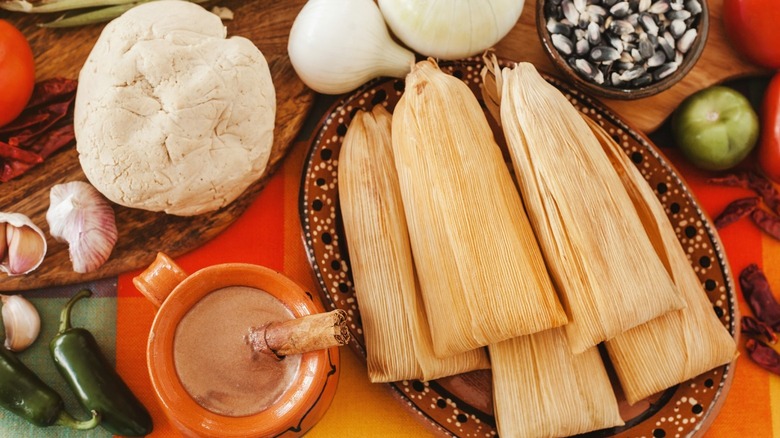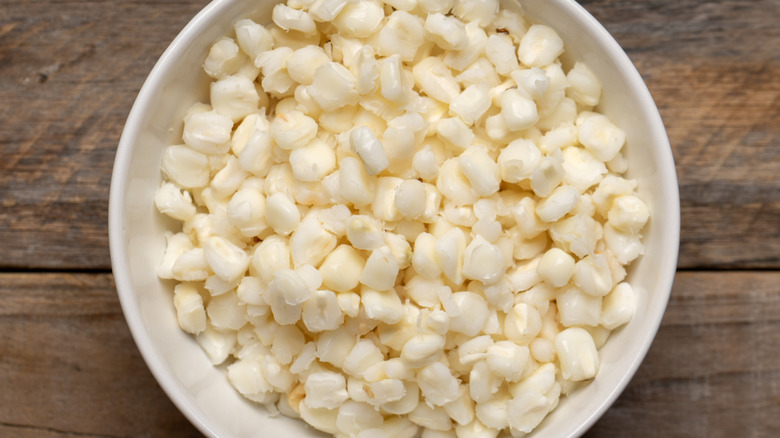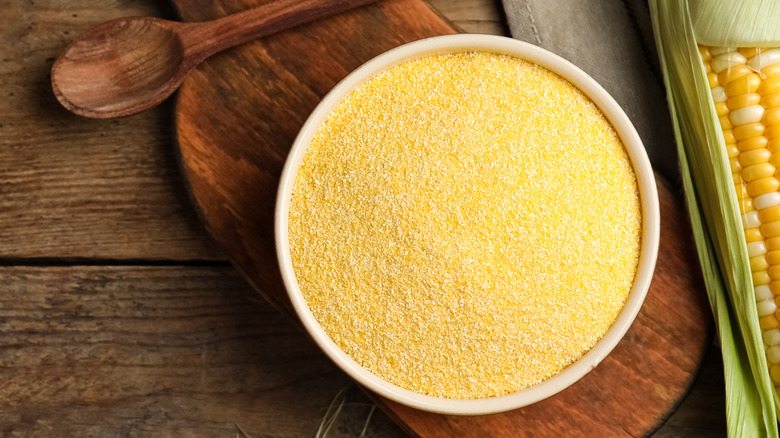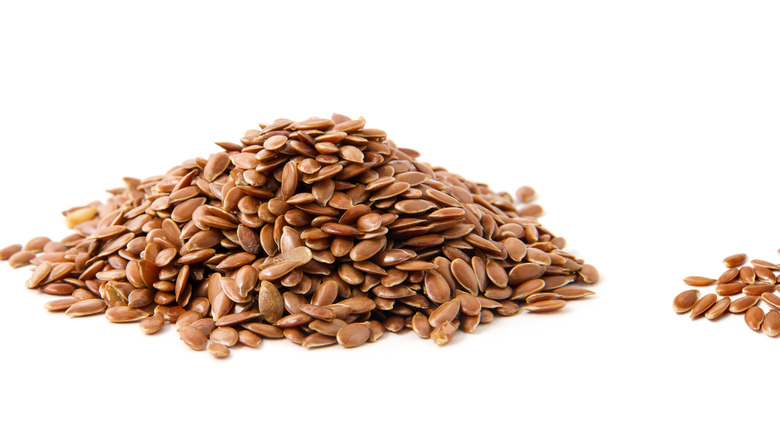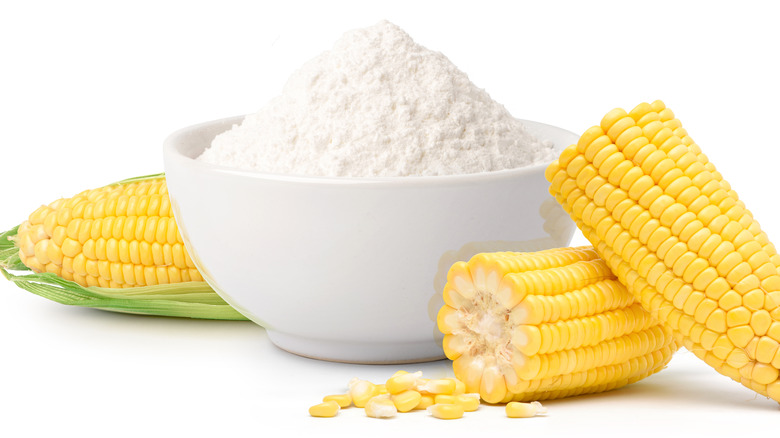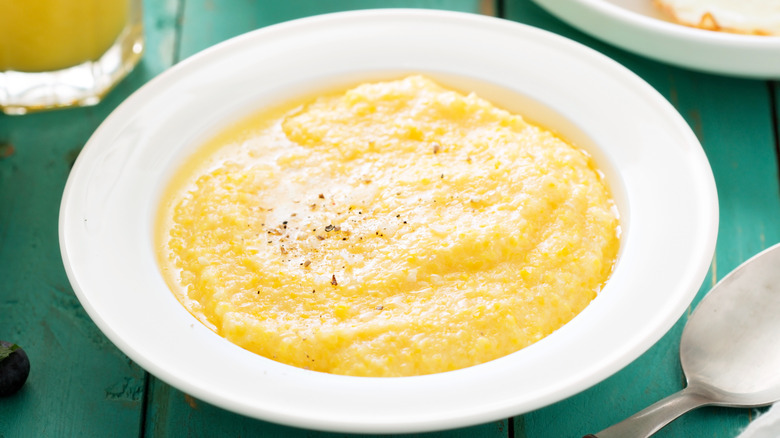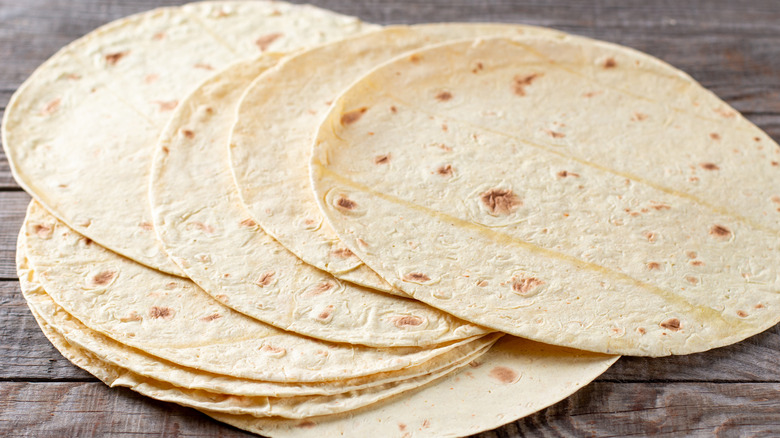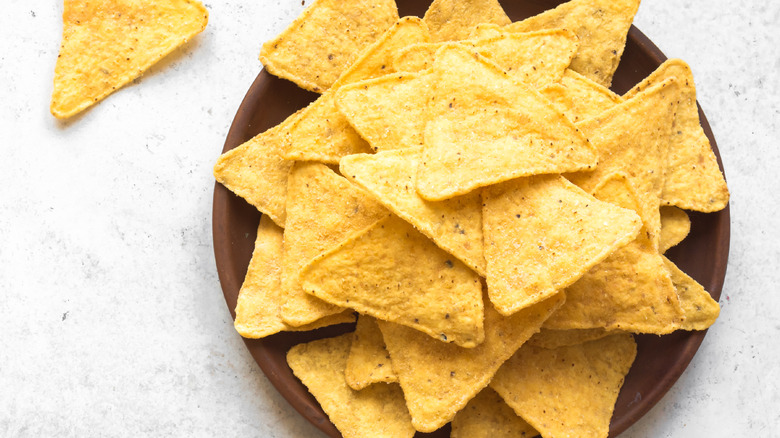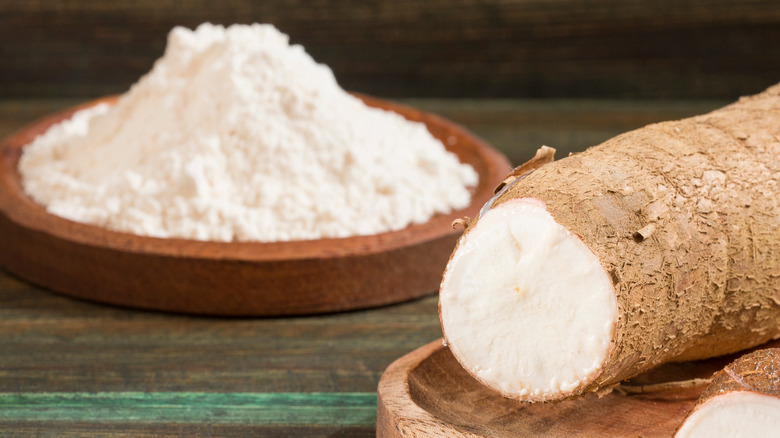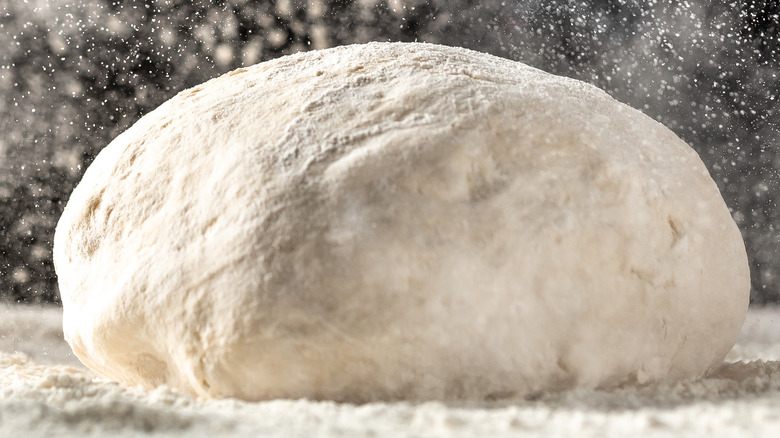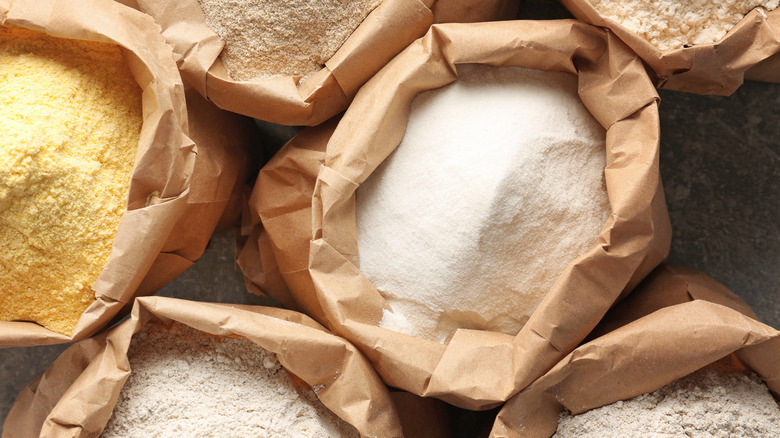10 Best Substitutes For Masa Harina
The regional preparations, cooking methods, and ingredients that compose Mexican cuisine are so diverse and influential that even UNESCO — the UN branch better known for identifying heritage buildings and monuments — has recognized this specific culinary preparation as an Intangible Cultural Heritage. Not to mention, some of the world's most commonly used foods — e.g. types of tomatoes, chilies, squashes, avocados, chocolate, and vanilla — all hail from Mexico.
But, if there's one specific Mexican foodstuff that has truly left an indelible mark on shaping many of the world's flavors and fusions, whether as a crop, animal feed, or the main component of many dishes, it's corn. According to North Dakota State University, Mexican civilizations have been harvesting and utilizing corn since around 7000 B.C. After unintentionally realizing that soaking corn kernels in ash or quicklime helped to make nutrients digestible, and loosen the kernel's outer shell, sometime between 1500-1200 B.C., the process formally became known as nixtamalization. It was at this moment that nixtamalized masa harina — or corn flour dough — became the standard preparation in Central America, forming the basis for tamales, empanadas, and of course, corn tortillas. Best of all, the ingredient is gluten-free!
Let's say, however, that you're looking for another carbohydrate to prepare masa harina, either due to an allergy, a dislike of the flavor of corn, a lack of supply, or any other reason. There are many alternatives, and we have 10 substitutes to consider in place of masa harina.
1. Hominy
Subtly sweet yet unabashedly earthy, hominy actually refers to the primary ingredient of masa harina, before it's ground. Unlike dent corn, however, hominy kernels are a type of flint corn, meaning they are pretty impossible to eat right off the cob. Hominy then refers to the corn kernels that have been soaked in a lime solution to remove the exocarp, giving us the soft interiors with which to cook. The canned stuff would be quicker to adapt as a masa harina substitute; however, dried hominy should be cooked to make the corn kernels more pliant.
There are two main types of hominy, white and yellow. White hominy has the entire husk removed, paving the way for grits. On the other hand, the sweeter, yellow hominy is more traditional in Mexican cooking, used in soups such as pozole and menudo. Per Bake It With Love, you can substitute ground hominy for masa harina in a 1:1 ratio.
2. Cornmeal
Although most famous in the U.S. for being the key ingredient in delicious Southern cornbread, gluten-free cornmeal is also widely consumed in Romania, Moldova, and Italy, where its coarser cousin is better known as polenta (per Real Simple). According to Gardening Know How, it's one of the three major types of corn that are grown in the U.S — those being grain, sweet, and pop — and cornmeal in particular comes from a grain corn called dent corn, which comes from the fact that it has ... a dent in it!
However, since the cornmeal is not generally nixtamalized, it could use a couple of squirts of lemon or lime juice to add the same light sour notes as masa harina. Still, cornmeal is overall much coarser than masa harina, so it's best to mix it with all-purpose flour when the goal is making tortillas via Lacademie, who suggests to "mix up 2 cups of flour with 2/3 cup of cornmeal and 1 1/3 cup of all-purpose flour to get a masa harina-like substance."
3. Flaxseed
If you thought flaxseeds existed just to throw on multigrain bread, or to get stuck in your teeth, you might want to know they can be a great substitute for masa harina, too. The flavor profile may be somewhat bitter, and completely lack the citrus qualities of nixtamalized masa harina, but flaxseeds more than make up for that with a range of possible health benefits.
In fact, according to Medical News Today, flaxseeds are often considered a "functional food," noted for being beneficial to your body. Some studies have found that flaxseeds have significant deposits of antioxidants, too, that may help fend off heart disease, and they contain Omega-3s, which have been known for fighting some types of cancer cells. They're also rich in fiber to aid in digestion.
More amusingly, if you have some leftover after making flax tortillas, you can even get to work on flax dashboards and clothing (per Agricultural Marketing Resource Center)! When substituting for masa harina, you'll want to use ground flaxseed and, per Bake It With Love, mix a 1/2-tablespoon of it with 2 tablespoons of water to use it as a replacement.
4. Cornstarch
It's amazing how versatile corn can be, given that it has been used not only as food, but also to power cars, create light clothing, and even clean your laundry. That last one rings especially true for cornstarch, also known as corn flour, created in 1842 by a factory worker named Thomas Kingsford (via My Recipes).
In essence, cornstarch is the starchy, white interior of a corn kernel that's been ground up into an extra fine powder. Nowadays, it's mostly used as a thickening agent, to add body and chewiness to foods such as ice creams, cookies, sauces, puddings, and soups. Thus, when substituting for masa harina, cornstarch is best used as a thickener, says Foods Guy. As they suggest, for every tablespoon of cornstarch used, mix it with an equal amount of a cold liquid to create the right texture. The idea is to prevent clumping, as you never want to overdo it with cornstarch.
5. Grits
If you hail from the Southern states or for any fans of Southern cooking, this substitute is probably well stocked in your kitchen — grits! With a coarser texture than cornmeal, grits are made from white or yellow hominy. In general, they're prepared like congee, or rice porridge where the kernels are boiled with water, milk, or any other liquid that you so desire, and served very creamy, often drowning in butter and cheese. And since they come from types of corn that are neither too sweet nor too starchy, grits can adapt to and absorb a multitude of flavors — just like tofu (per Foods Guy).
However, given their coarser, grittier texture — the hint's in the name — when being called upon instead of masa harina, grits are best used for applications where it's a thickener. Think soups, sauces, caldos, or stews. Use in a 1:1 ratio.
6. Tortillas
After the big game, you probably still have some Lay's hiding under the rug, salsa dripping off the countertop, and tortillas in towers after assembling that fajita buffet. And if you do have corn tortillas — especially the regular ones, since flavored options might be too overpowering — you're on your way to another masa harina substitute.
Even if the tortillas that you have are stale, as long as there's no mold growing on them, you're in the clear to repurpose them in this way. To yield the equivalent of one cup of masa harina, shred and grind up three to four tortillas, and then add Kosher salt and hot water to the mix. Deposit the mixture into a food processor, and keep checking for just the right texture until ready, as suggested by Lacademie.
7. Tortilla Chips
If the goal is to serve an authentic Mexican meal at your homestead, you may want to think twice about shoveling those tortilla chips in salsa and save them for a masa harina substitute. If you're fresh out of the latter, and there's no time for supermarket shopping, tortilla chips are a great understudy — corn taco shells, too. In fact, they're already made out of masa harina, plus water and salt, but the kicker is that the chips also contain preservatives, giving them longer shelf-lives.
Per Lacademie, to turn them into dough, food processors are surely your best bet, though you could also shove a bunch of chips in a baggie, then pound them with a mallet down to fine powder until you get the same amount of masa harina you would have needed. Be careful with adding particularly salty ingredients in the dish you're making if you use this substitute, since they generally come salty all on their own.
8. Arrowroot Powder
Arrowroot powder might be pricier than the tortilla or cornstarch substitutes, but it has three principal benefits that come along with it. One, in addition to being gluten-free, it's flavorless, meaning that it doesn't strive to overpower the main meal. Two, since it comes from a plant, most commonly the West Indian arrowroot, it remains as natural as possible and chemicals are typically not added to it. And lastly, it doesn't require fat or high temperatures in order to serve as a binding agent.
However, according to Lacademie, if you intend to use this masa harina substitute with any dairy products, then think again, because the results would be akin to the stuff Bill Murray was attacked with in "Ghostbusters." When measuring, for best results use equal amounts of arrowroot powder and any cold non-dairy liquid in a 1:1 ratio to masa harina (via Foods Guy).
9. Masa Preparada
Literally translated from Spanish to "prepared dough," masa preparada is named that way because it's made from freshly ground hominy, and thus doesn't have a long shelf life. Therefore, it's unlikely that you will find it in too many stores, beyond Latin American grocers and other specialty shops.
There are two primary types of masa preparada. Smooth masa is ideal for making corn tortillas, whereas coarse masa, when mixed with manteca or lard, is better for tamales and arepas or pupusas, those delightful Latin American patties often stuffed with cheese and beans. Better yet, the coarser stuff can last months when properly sealed in the fridge (via The Kitchn).
Using masa preparada means you don't have to worry about proportions of wet and dry ingredients, either, or the correct dough consistency; it's a shortcut, helping you to skip a few steps in making tortillas, or whichever your desired dish may be (per Foods Guy). Use in a 1:1 ratio as what's called for masa harina.
10. Varied Flours
Finally, if you're really into experimenting, try using any type of flour that you see fit as a substitute. Masa harina might fundamentally have that slightly citrus and alkaline flavor, but if you and your friends are into doing your own version of the popular TV show "Chopped," you can choose anything from barley and millet to ... good ol' wheat flour. The latter of course is a staple in many U.S. households, and does everything from thicken soups and sauces to helping you bake that delicious baguette. Of course, there are many types of wheat flours on the market, including the silky Double O from Italy, and all-purpose flour with a higher protein content (via Everyday Food on YouTube).
Overall, wheat flours will be earthier than nixtamalized corn, but that's part of the beauty in look for food substitutes; if you don't try something, you'll never know how it is! Per Bake It With Love, "Begin with about half [the amount of flour] of what the recipe calls for [with masa harina] and then slowly add it, paying attention to how it thickens. It may take more or less depending on the flour you substitute."
